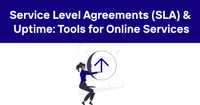How Do SLAs, SLOs and SLIs Differ?
For any organization providing digital services, understanding the distinctions between Service Level Agreements (SLAs), Service Level Objectives (SLOs), and Service Level Indicators (SLIs) is crucial. These concepts form the backbone of service level management, helping businesses set, measure, and meet customer expectations. Let's dive into each of these terms and explore how they work together to ensure service quality and reliability.
Table of Contents
- Introduction to Service Level Management
- Service Level Agreement (SLA)
- Service Level Objective (SLO)
- Service Level Indicator (SLI)
- Key Differences Between SLA, SLO, and SLI
- Implementing Effective Service Level Management
- Common Challenges and Solutions
- The Role of Monitoring in Service Level Management
- Best Practices for SLA, SLO, and SLI Management
- Future Trends in Service Level Management
- Conclusion
Introduction to Service Level Management
Service level management is a critical aspect of IT service delivery. It's all about setting expectations, measuring performance, and continuously improving the quality of services provided to customers. The three pillars of service level management - SLAs, SLOs, and SLIs - work together to create a framework for delivering reliable and high-quality services.
I've seen many organizations struggle with these concepts, often using them interchangeably or failing to implement them effectively. But trust me, getting a handle on these terms can make a world of difference in how you manage and deliver your services.
Service Level Agreement (SLA)
An SLA is a formal contract between a service provider and a customer that defines the expected level of service. It's the big kahuna of service level management - the document that lays out what the customer can expect and what happens if those expectations aren't met.
Key components of an SLA typically include:
- Service description
- Performance metrics
- Roles and responsibilities
- Reporting procedures
- Penalties for non-compliance
Here's the thing about SLAs - they're not just legal mumbo-jumbo. They're a communication tool that aligns expectations between you and your customers. Get them right, and you'll have a solid foundation for a great business relationship. Get them wrong, and you're in for a world of hurt.
I once worked with a company that had overpromised in their SLAs, committing to 99.999% uptime for all their services. Sounds great, right? Well, it was a nightmare. They were constantly in breach of their agreements, paying out penalties left and right. The lesson? Be realistic in your SLAs. It's better to underpromise and overdeliver than the other way around.
Service Level Objective (SLO)
If SLAs are the big picture, SLOs are where the rubber meets the road. An SLO is a specific, measurable goal for service performance. It's the target you're aiming for to meet your SLA commitments.
SLOs typically focus on metrics like:
- Availability (e.g., 99.9% uptime)
- Response time (e.g., 99% of requests processed in under 200ms)
- Error rate (e.g., less than 0.1% of requests result in errors)
Here's a little secret: good SLOs are like Goldilocks' porridge - not too hot, not too cold, but just right. Set them too low, and you're not pushing yourself to improve. Set them too high, and you'll drive yourself (and your team) crazy trying to meet impossible standards.
I remember working on a project where we set our SLO for response time at 100ms for 99.99% of requests. Sounds impressive, right? Well, it was a disaster. We spent so much time and resources trying to squeeze out those last few milliseconds that we neglected other important aspects of our service. Don't fall into that trap.
Service Level Indicator (SLI)
Now we're getting into the nitty-gritty. SLIs are the actual measurements of service performance. They're the raw data that tell you whether you're meeting your SLOs (and by extension, your SLAs).
Common SLIs include:
- Actual uptime percentage
- Measured response times
- Error rates
- Throughput
Think of SLIs as the speedometer on your car. They give you real-time feedback on how you're doing. Are you speeding? Cruising along nicely? Or maybe you're about to stall out? That's what SLIs tell you about your service performance.
But here's the catch - you need to choose your SLIs wisely. Measure too many things, and you'll drown in data. Measure the wrong things, and you'll be optimizing for the wrong outcomes. It's a balancing act, and it takes some trial and error to get it right.
Key Differences Between SLA, SLO, and SLI
Now that we've covered each concept individually, let's break down the key differences:
-
Purpose
- SLA: Defines the overall service commitment and sets customer expectations
- SLO: Establishes specific, measurable goals for service performance
- SLI: Provides actual measurements of service performance
-
Scope
- SLA: Broad, covering multiple aspects of service delivery
- SLO: Focused on specific performance targets
- SLI: Highly specific, measuring individual performance metrics
-
Audience
- SLA: External (customers) and internal (service providers)
- SLO: Primarily internal (service providers)
- SLI: Internal (technical teams and management)
-
Formality
- SLA: Formal, often legally binding
- SLO: Less formal, but still structured
- SLI: Informal, used for operational monitoring
-
Timeframe
- SLA: Long-term (often annually reviewed)
- SLO: Medium-term (reviewed quarterly or monthly)
- SLI: Short-term (monitored continuously)
Here's a table to summarize these differences:
| Aspect | SLA | SLO | SLI |
|---|---|---|---|
| Purpose | Define service commitment | Set specific goals | Measure actual performance |
| Scope | Broad | Focused | Highly specific |
| Audience | External and internal | Primarily internal | Internal |
| Formality | Formal, legally binding | Less formal, structured | Informal, operational |
| Timeframe | Long-term | Medium-term | Short-term, continuous |
Understanding these differences is crucial for effective service level management. It's not just about having these elements in place - it's about using them in harmony to drive service improvement and customer satisfaction.
Implementing Effective Service Level Management
Implementing SLAs, SLOs, and SLIs isn't a walk in the park. It requires careful planning, cross-functional collaboration, and ongoing commitment. Here's a high-level approach to get you started:
-
Start with your SLAs. Work with your business and legal teams to define realistic, achievable service commitments.
-
Break down your SLAs into specific SLOs. These should be measurable targets that, if met, will ensure you're meeting your SLA commitments.
-
Identify the SLIs that will help you track progress towards your SLOs. Choose metrics that are meaningful, measurable, and actionable.
-
Implement monitoring and reporting systems to track your SLIs in real-time.
-
Regularly review and adjust your SLOs based on your SLI data and changing business needs.
-
Use your SLI data to inform decisions about service improvements and resource allocation.
Remember, this isn't a one-and-done process. It's an ongoing cycle of setting goals, measuring performance, and making improvements.
Common Challenges and Solutions
Implementing effective service level management isn't without its challenges. Here are some common pitfalls and how to avoid them:
-
Overpromising in SLAs Solution: Be realistic. It's better to start conservative and improve over time than to set yourself up for failure.
-
Too many SLOs Solution: Focus on what matters most. Choose a handful of key metrics that truly reflect service quality from the customer's perspective.
-
Choosing the wrong SLIs Solution: Align your SLIs closely with your SLOs and ultimately your SLAs. If an SLI doesn't help you track progress towards an SLO, it's probably not worth measuring.
-
Lack of accountability Solution: Clearly define roles and responsibilities for meeting SLOs. Make sure everyone understands how their work impacts service performance.
-
Ignoring the data Solution: Regularly review your SLI data and use it to drive decision-making. If you're consistently missing an SLO, figure out why and make changes.
The Role of Monitoring in Service Level Management
You can't manage what you can't measure. That's where monitoring comes in. Effective monitoring is the backbone of successful service level management. It provides the data you need to track SLIs, evaluate performance against SLOs, and ultimately ensure you're meeting your SLAs.
But not all monitoring is created equal. Here are some key considerations:
-
Real-time monitoring: In today's fast-paced digital world, you need to know about issues as they happen, not hours or days later.
-
End-to-end visibility: Monitor your entire service stack, from infrastructure to application performance.
-
User experience monitoring: Don't just focus on backend metrics. Monitor the actual user experience to ensure you're delivering what matters most to your customers.
-
Automated alerting: Set up alerts based on your SLOs so you can proactively address issues before they impact your SLAs.
-
Historical data analysis: Keep historical performance data to identify trends and inform future SLO setting.
Investing in robust monitoring tools and practices is essential for effective service level management. It's not just about avoiding downtime - it's about continuously improving your service quality and reliability.
Best Practices for SLA, SLO, and SLI Management
Based on my experience, here are some best practices for managing SLAs, SLOs, and SLIs:
-
Keep it simple: Start with a small set of critical SLOs and SLIs. You can always add more as you mature your processes.
-
Align with business goals: Your SLAs, SLOs, and SLIs should reflect what's truly important to your business and your customers.
-
Communicate clearly: Ensure everyone in your organization understands your SLAs, SLOs, and SLIs and their role in meeting them.
-
Review regularly: Service level management is not a set-it-and-forget-it process. Review and adjust your SLAs, SLOs, and SLIs regularly based on performance data and changing business needs.
-
Use error budgets: Consider implementing error budgets to balance reliability with innovation. This approach, popularized by Google, allows for some level of acceptable errors or downtime, giving teams more flexibility to push changes and improvements.
-
Automate where possible: Use tools to automate SLI data collection, SLO tracking, and SLA reporting. This reduces manual effort and improves accuracy.
-
Learn from incidents: Use postmortems after major incidents to identify areas for improvement in your SLOs and SLIs.
-
Celebrate successes: Recognize and reward teams when SLOs are consistently met. This helps build a culture of reliability.
Future Trends in Service Level Management
The field of service level management is constantly evolving. Here are some trends I'm keeping an eye on:
-
AI and Machine Learning: These technologies are being increasingly used to predict SLO breaches before they happen, allowing for proactive management.
-
Customer-centric SLOs: There's a growing focus on defining SLOs based on actual customer experience rather than just technical metrics.
-
Dynamic SLAs: Some organizations are experimenting with SLAs that automatically adjust based on real-time conditions and usage patterns.
-
Increased granularity: As monitoring tools become more sophisticated, we're seeing a trend towards more granular SLIs and SLOs, allowing for finer-tuned service management.
-
Integration with DevOps practices: SLOs are becoming an integral part of the development process, with some teams even implementing "error budgets" based on SLO performance.
-
Emphasis on business impact: There's a growing trend to tie SLAs and SLOs directly to business outcomes, making their importance clearer to non-technical stakeholders.
As these trends evolve, the key will be to stay flexible and keep adapting your approach to service level management.
Conclusion
SLAs, SLOs, and SLIs are powerful tools for managing service quality and reliability. When used effectively, they create a virtuous cycle of setting expectations, measuring performance, and driving improvements.
Remember, the goal isn't just to meet a set of numbers - it's to deliver a great experience to your users. Use these tools to focus on what truly matters to your customers and your business.
Implementing effective service level management isn't easy, but the benefits are well worth the effort. It leads to happier customers, more efficient operations, and a stronger, more reliable service.
For those looking to improve their website and API monitoring capabilities, including SSL certificate monitoring and public status pages, Odown.com offers a comprehensive solution. With real-time monitoring, detailed performance metrics, and customizable alerts, Odown can help you track your SLIs, meet your SLOs, and ultimately deliver on your SLAs. By providing visibility into your service performance and quick notification of any issues, Odown enables you to maintain high service quality and reliability, keeping your customers satisfied and your business running smoothly.



